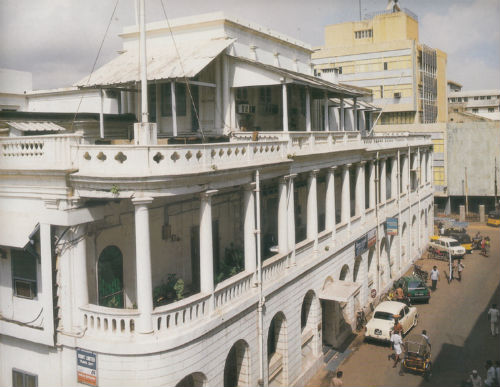Registered with the Registrar of Newspapers for India under R.N.I 53640/91
Vol. XXVII No. 14, November 1-15, 2017
Flattened with impunity
By The Editor
Dark days for heritage conservation

The Binny headquarters in the 1980s
Tamil Nadu may have a Heritage Act and Chennai city a Heritage Conservation Committee, but there is really no protection for heritage structures even if they are listed and recognised as such in judgements by the High Court of Madras. Those concerned with conservation and preservation of historic structures are made painfully aware of this fact every now and then. The most recent instance has been the demolition of the historic Binny building on Armenian Street.
If you went strictly by the rulebook, this structure could not be demolished. Going by the 2010 judgement of the High Court of Madras, delivered on writ petition no. 25306 of 2006, this was one of 400 odd buildings of the city recognised to be of historic importance. The structure was accorded Grade 2 status, meaning its façade could not be changed and its interiors modified only to an extent. All such changes had to be done only after permission from the Heritage Conservation Committee (HCC) of the Chennai Metropolitan Development Authority. That Committee had been constituted in terms of this judgement and it was to notify owners of all heritage buildings that demolitions were not to be contemplated. The owners of the Binny building were also duly written to.
The structure was not maintained in any way thereafter and then, most conveniently for the owners, a fire, which is now more or less a given in all heritage buildings of the city (and not surprisingly, given the neglect, the availability of dry timber and age-old electric wiring), swept through the interior. It did not in any way structurally damage the building and its façade at least was rock solid. But that did not prevent the owners from approaching the Department of Housing and Urban Development for a -no-objection certificate to demolish. This document, which experience has shown us is not very difficult to obtain, facilitated the Corporation of Greater Chennai to permit demolition, which of course was done with an alacrity never seen when maintenance or conservationhas to be done.
The HCC, it appears, was never consulted. If this was indeed so, it is a downright violation of court orders. It also goes to show how anybody who knows their way through the labyrinthine corridors of the Government can circumvent the law. It is clearly mandated that the HCC is the overall authority when it comes to changes in heritage structures and if it has been bypassed, then the owners are clearly in the wrong. If indeed the HCC was consulted and gave its consent to demolish, then it is that body which is answerable.
Whatever be the truth, the fact is that the building, which represented over 200 years of corporate history in the city, has now vanished. It was also the birthplace of the Madras Chamber of Commerce and Industry, which body, founded in 1836, is the second-oldest trade representative organisation of India. The Madras Labour Union, India’s oldest, was founded to band together the workers of Binny. The company itself, one of South India’s largest, employed in its heyday over 25,000 workers at its Pulianthope mills. It folded up in the 1980s.
But that is not all. As this article goes to press, we understand that Leith Castle, in San Thomé, is also well on its way out. Also listed in the same judgement, its sale and permission to demolish are all wrapped in secrecy.
All this is a sad commentary on the seriousness of the Tamil Nadu Government when it comes to heritage conservation. It also goes to show that the best of judgements and the most comprehensive of Acts can be rendered toothless by a pliant administration and a greedy real estate lobby.

